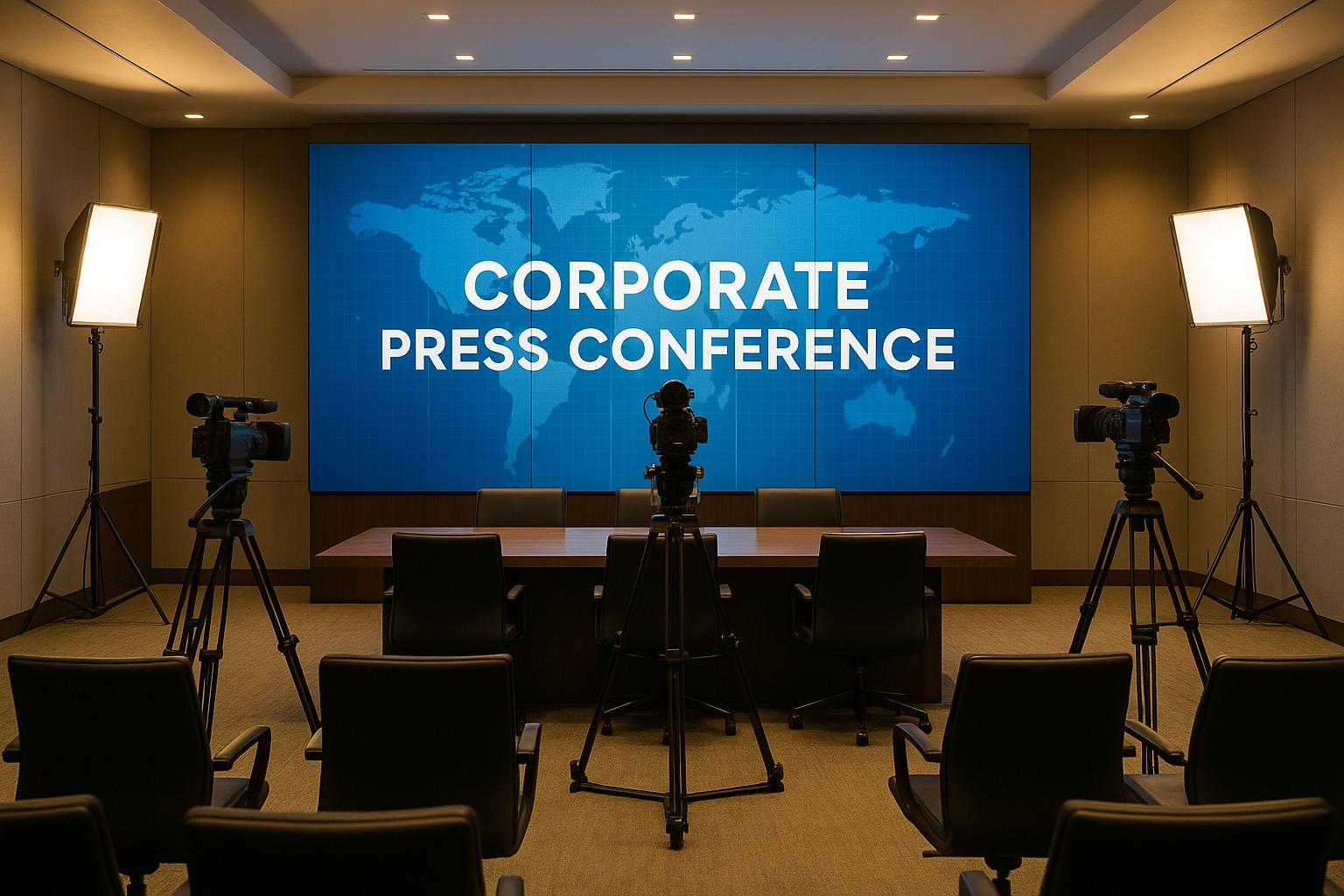5 Ways Leadership Conferences Impact Employee Retention And Morale

Chief Executive Officer

Leadership conferences can help reduce employee turnover and increase morale. They focus on professional growth, team building, and improving workplace relationships. Here's how they make a difference:
- Career Development: Employees gain new skills and insights, boosting confidence and job satisfaction.
- Team Connections: Conferences strengthen relationships among colleagues, improving collaboration.
- Fresh Perspectives: Attendees return with actionable ideas that improve their roles and workplace dynamics.
- Better Communication: Managers and employees learn to work together more effectively, fostering mutual respect.
- Cost Savings: Lower turnover rates and improved productivity outweigh the investment in these events.
EP 53: The Power Of Trust: How Leadership Drives Employee Retention
1. Building Professional Growth and Career Development
Reducing employee turnover starts with empowering individuals to grow professionally, and leadership conferences play a key role in making this happen. These events provide employees with opportunities to enhance their skills while gaining insights into the latest industry trends, strategies, and technologies. The result? Employees not only sharpen their technical abilities but also improve their interpersonal skills, setting the stage for career advancement.
Connection to Professional Development
Leadership conferences go beyond the basics of workplace training, offering attendees a chance to develop essential skills like strategic thinking, effective communication, conflict resolution, and decisive leadership. They also help participants master practical abilities such as public speaking, time management, and team management - skills that directly improve job performance.
Consider this: 87% of participants reported gaining skills they could immediately apply to their jobs, and 91% said they walked away with a deeper understanding of their field. This kind of immediate impact allows employees to return to work better equipped to contribute at a higher level.
Another major benefit of these conferences is the networking opportunities they create. Employees can connect with industry leaders, discover mentors, and uncover career paths that traditional methods might not reveal. These connections, paired with new skills, not only enhance individual performance but also boost morale and engagement.
Boost to Employee Morale
The psychological benefits of professional development can't be overstated. After attending leadership conferences, 90% of participants reported feeling more confident at work, and 84% said they were more assured in making business decisions. This increased confidence translates into higher morale and greater job satisfaction.
When companies prioritize employee growth, it sends a clear message: "We value you." Learning new skills and gaining fresh perspectives fosters a sense of achievement and renewed excitement for work. This enthusiasm often leads to stronger loyalty, as employees who feel invested in are less likely to look elsewhere.
Impact on Employee Retention
The link between professional development and employee retention is undeniable. 94% of employees say they would stay longer at a company that invests in their growth, while 70% admit they'd consider leaving for an employer that offers better training opportunities. Leadership conferences address a critical issue - 74% of workers feel that a lack of development opportunities holds them back from reaching their potential.
"Companies need to make learning feasible: provide time, reduce friction, and embed development into the flow of work." - Rachel Kerrigan, Associate Director of Strategic Alliances, HBS Online
Measurable Organizational Benefits
Investing in leadership conferences doesn’t just benefit employees; it also pays off for the organization. Participants often return with a renewed sense of initiative, leading to promotions and reduced turnover. This creates a positive cycle where top talent is retained and motivated to grow within the company. Additionally, a workforce with enhanced skills is better prepared to adapt to evolving business challenges, driving innovation and keeping the organization competitive.
2. Building Team Connections and Company Culture
Leadership conferences offer a unique opportunity to strengthen bonds among employees while reinforcing the company’s core values. When team members attend these events together, they share experiences that build trust, improve communication, and foster connections that extend well beyond the conference itself. This foundation of trust can lead to higher morale and stronger employee retention.
Boost to Employee Morale
Attending conferences as a team goes beyond the typical team-building activities. These events combine professional growth with relationship-building in a way that feels more organic and impactful.
Workshops and breakout sessions encourage employees to work together, solve challenges, and exchange ideas. These shared moments create a sense of camaraderie that carries over into the workplace, leading to better relationships and higher morale.
When employees feel connected to their colleagues, they’re more likely to enjoy their work environment. The friendships and professional ties formed during these events often result in better collaboration, greater job satisfaction, and a workplace culture that employees genuinely appreciate.
Impact on Employee Retention
The connections made at leadership conferences can significantly influence employee loyalty. Strong workplace relationships are a key factor in retaining talent, and these events provide a platform for employees to interact with colleagues they might not usually engage with. Cross-departmental connections formed during conferences often lead to improved collaboration and a stronger sense of belonging within the company.
When employees feel a sense of loyalty - not just to the company but to the people they work with - they’re less likely to consider leaving. The shared experiences and mutual goals established during conferences create bonds that are hard to break.
Additionally, networking opportunities at these events often reveal new career paths within the organization. By connecting with leaders and colleagues from other departments, employees gain visibility into potential growth opportunities. This internal awareness can prevent talented team members from seeking advancement elsewhere, fostering a deeper commitment to the organization’s success.
Measurable Organizational Benefits
Organizations that invest in leadership conferences often see noticeable improvements in workplace culture metrics. Teams that attend together frequently report higher collaboration, better communication, and increased engagement in post-event surveys. These benefits often ripple throughout the organization, inspiring other teams and departments.
The influence of these events extends beyond the attendees themselves. Employees who participate in leadership conferences often return as advocates for positive change, sharing new ideas about teamwork, communication, and leadership with their colleagues. This knowledge-sharing helps spread the benefits of the conference across the entire organization.
Improved internal communication and reduced workplace conflicts are additional advantages. The relationship-building aspect of leadership conferences helps employees develop stronger interpersonal skills, leading to smoother collaboration and more effective teamwork. These improvements often translate into higher productivity, better project outcomes, and a more cohesive work environment that supports long-term success.
3. Motivating Employees Through New Ideas and Perspectives
Leadership conferences have a unique way of reigniting employee motivation by introducing attendees to fresh ideas and the latest industry trends. These events go beyond professional development - they spark curiosity and inspire employees to think differently about their work. By learning about emerging technologies, modern management approaches, and innovative business strategies, employees return with actionable insights that can lead to immediate workplace improvements.
Boost to Employee Morale
Fresh ideas can breathe new life into a workplace that feels stagnant. Conference sessions often challenge conventional thinking and present alternative solutions to everyday problems. This exposure encourages employees to view their roles from a new perspective, uncover previously overlooked solutions, and feel a renewed sense of purpose and optimism about their career paths.
Additionally, when employees are given access to cutting-edge industry knowledge, they feel valued and supported in their growth. This investment in their development sends a clear message: the organization is committed to staying competitive and progressive. That sense of pride and confidence in being part of such a forward-thinking team has a significant impact on morale.
Connection to Professional Development
Leadership conferences serve as a bridge between theory and practice. Attendees gain insights from real-world case studies, success stories, and lessons shared by industry leaders who have tackled similar challenges. These learnings can be directly applied to their roles, making professional growth more tangible.
Moreover, conferences often open employees' eyes to new career paths or skillsets they hadn’t previously considered. Whether it’s learning about emerging roles, technologies, or industry shifts, this exposure helps employees see how they can grow within their current organization or prepare for future opportunities.
The knowledge gained doesn’t just benefit individuals - it strengthens teams. Employees who return from conferences equipped with new strategies and insights often contribute more effectively to strategic decisions, whether it’s identifying market trends, addressing customer needs, or improving internal operations.
Impact on Employee Retention
When employees feel intellectually stimulated and challenged, they’re more likely to stay with their current employer. The inspiration gained from leadership conferences can help them see untapped potential in their existing roles, reducing the urge to seek opportunities elsewhere. This renewed sense of possibility often translates into greater loyalty and commitment to the organization.
Beyond personal growth, conference attendance also signals that the company values innovation and continuous learning. Employees take note when their organization prioritizes staying ahead of industry trends, which reassures them about the company’s long-term stability and growth potential.
Measurable Organizational Benefits
The benefits of leadership conferences extend beyond individual attendees - they ripple throughout the organization. Companies often see immediate improvements in employee engagement and productivity. New ideas lead to more active participation in meetings, creative project proposals, and a greater willingness to tackle challenging assignments. Employees also begin to think more strategically, bringing fresh perspectives to their work.
When attendees share what they’ve learned with their teams, the impact multiplies. Teams exposed to these new insights often report better problem-solving approaches and more innovative solutions to ongoing challenges, creating a culture of continuous improvement and collaboration.
sbb-itb-ae35a94
4. Improving Manager-Employee Relationships and Communication
Leadership conferences bring managers and employees together to build stronger communication and better workplace relationships. By attending these events side by side, both groups are exposed to the same leadership strategies, communication techniques, and management practices. This shared learning experience helps close gaps in understanding and fosters smoother collaboration.
Interactive sessions play a big role in encouraging open conversations across all levels. Workshops on active listening, constructive feedback, and conflict resolution provide managers with actionable tools they can use right away. At the same time, employees gain a clearer view of the challenges their managers face, promoting mutual understanding and teamwork.
Connection to Professional Development
These conferences often include sessions that directly address how managers and employees can work better together. For instance, managers learn how to hold impactful one-on-one meetings and deliver meaningful feedback. Employees, on the other hand, gain skills to express their needs more effectively and align their efforts with team goals.
When managers apply these techniques, they create an environment where career growth is supported. Employees who grasp leadership perspectives tend to take more initiative in their roles and are more open to mentorship and guidance. Better communication naturally leads to higher morale, as everyone feels more connected and valued.
Boost to Employee Morale
Improved communication skills gained from leadership conferences often translate into noticeable changes for employees. Managers start listening more attentively, checking in more frequently, and setting clearer expectations. These behaviors make employees feel appreciated and supported in their professional and personal growth.
Another major morale booster is the increased transparency that managers bring back from these conferences. When managers openly share updates about the company’s direction, project goals, and performance expectations, it reduces uncertainty and helps employees feel more engaged with the organization’s mission.
Impact on Employee Retention
Strong manager-employee relationships, built on open communication, directly influence employee retention. Leadership conferences that strengthen these bonds have a lasting impact. Employees who feel supported, heard, and valued by their managers are far less likely to leave for other opportunities.
The trust developed through better communication creates a stable and positive work environment. Open dialogue further reinforces the organizational culture, making employees more committed to their roles and the company’s overall success.
Measurable Organizational Benefits
Organizations that prioritize leadership conferences focusing on communication often see measurable improvements. Employee satisfaction scores rise, and managers are rated more highly for their supportiveness and effectiveness. These gains are often reflected in internal surveys within months of attending such events.
Better communication also reduces misunderstandings, speeds up project timelines, and boosts overall efficiency. This improved dialogue is a key factor in the broader benefits that leadership conferences bring to an organization.
5. Providing Measurable ROI Through Lower Turnover and Cost Savings
Leadership conferences offer a clear return on investment by delivering cost savings that organizations can track. These savings often stem from reduced turnover, improved employee engagement, and stronger internal expertise, all of which contribute to a healthier bottom line.
Impact on Employee Retention
Investing in leadership development can significantly lower the costs associated with replacing employees. By using these conferences to build stronger relationships between managers and their teams while outlining clear career paths, organizations create an environment where employees feel valued and see potential for long-term growth. This often leads to noticeable improvements in retention rates, saving companies the expense and disruption of frequent turnover.
Tangible Organizational Benefits
Better retention is just the beginning. Organizations also benefit from enhanced internal expertise, which can reduce the need for costly external training programs. Employees who return from leadership conferences often bring renewed energy and engagement, boosting productivity and even cutting down on absenteeism. Over time, experienced employees can become mentors to newer team members, creating a self-sustaining cycle of knowledge-sharing that further reduces reliance on external resources.
Driving Professional Growth
Leadership conferences act as a springboard for professional development. Attendees gain insights from industry peers, exchange best practices, and return better equipped to advance their careers. This continuous learning not only strengthens individual career paths but also reduces the need for external recruitment efforts, cutting associated costs and ensuring that talent development happens in-house.
Positive Impact on Employee Morale
When employees feel valued and supported, their morale improves - and this has ripple effects throughout the organization. Teams in positive work environments often require less oversight, allowing managers to focus on strategic goals. Additionally, motivated employees are more likely to provide excellent customer service, which enhances the company’s reputation and helps attract top talent.
In short, leadership conferences are a strategic investment that pays off in multiple ways. From lowering turnover costs to boosting productivity and fostering a more engaged workplace culture, these events deliver measurable benefits that strengthen organizations from the inside out.
Cost Comparison Table
Let's break it down: the cost of replacing a valuable employee often dwarfs the expense of sending them to a leadership conference. While exact figures can vary, the pattern is consistent - investing in leadership development is far more economical than dealing with employee turnover.
Replacing a mid-level manager can cost several times their annual salary when you factor in recruitment, lost productivity, and onboarding. On the other hand, the cost of sending someone to a leadership conference is just a small fraction of that. When you look at the big picture, the cumulative expenses of turnover can add up quickly, making leadership development a smart and cost-effective choice. The table below provides a side-by-side comparison of these costs.
| Cost Category | Employee Turnover Costs | Leadership Conference Investment |
|---|---|---|
| Mid-level Manager | Several times their annual salary | A fraction of the turnover cost per attendee |
| Senior Professional | Multiple times their annual salary | Moderate compared to turnover expenses |
| Executive Level | Even higher relative to annual salary | Still favorable compared to turnover costs |
| Team of 10 Employees | Significant cumulative expenditure | Scales favorably relative to overall turnover |
Conclusion
Leadership conferences play a key role in improving workforce performance. They encourage professional development, help build stronger team connections, inspire new ideas, and improve communication between managers and employees. On top of that, these events address retention issues by lowering turnover rates and boosting employee loyalty.
In short, leadership conferences are an investment in your organization's greatest resource - its people. They provide a meaningful way to cultivate a motivated and resilient team.
FAQs
How do leadership conferences help improve employee retention?
Leadership conferences are a powerful tool for boosting employee retention by promoting professional development, teamwork, and motivation. These events give employees the chance to explore modern leadership strategies, gain fresh perspectives, and build new skills. This not only helps them grow but also makes them feel appreciated and driven.
For managers and leaders, these conferences offer practical tools to tackle workforce challenges, such as improving employee engagement and fostering a positive workplace environment. When employees witness their company prioritizing their development and well-being, it builds a sense of loyalty and commitment to the organization.
How can companies apply the benefits of leadership conferences to improve daily operations?
Companies can take the insights gained from leadership conferences and seamlessly integrate them into their everyday operations by focusing on practical strategies that promote growth. A great starting point is to emphasize employee development. This could mean rolling out targeted training programs or establishing mentorship opportunities that not only enhance skills but also keep employees engaged and invested in their roles.
Another key area to address is fostering a workplace culture that thrives on collaboration, inclusivity, and recognition. Celebrate milestones, encourage open dialogue, and make sure every team member feels appreciated. When these principles are consistently applied, businesses can see a noticeable improvement in morale, retain their top performers, and cultivate a highly motivated team.
Are leadership conferences only meant for managers, or can employees at all levels benefit from them?
Leadership conferences offer benefits that extend well beyond just managers - they’re valuable for employees at every level of an organization. These events often dive into topics like professional growth, teamwork, and creating a positive workplace environment. And let’s be honest, these are areas that can help anyone contribute more effectively to their team and company.
Attending a leadership conference can open the door to fresh ideas, new skills, and a stronger connection to your company’s goals. Many of these events also focus on actionable strategies to boost employee engagement and satisfaction, making them relevant whether you’re a team member, manager, or executive. No matter your role, you’ll walk away with tools to grow and excel.
Related Blog Posts









